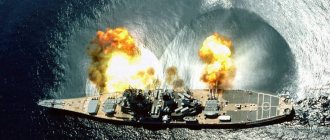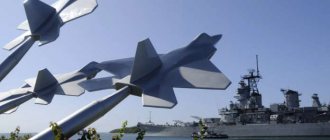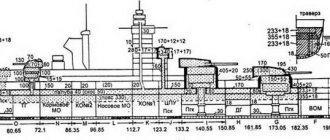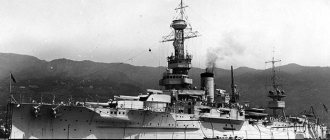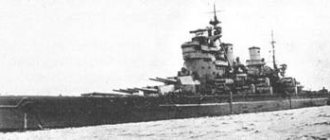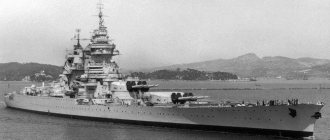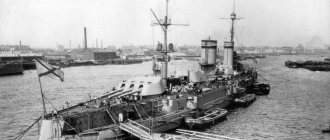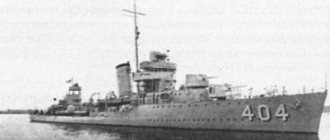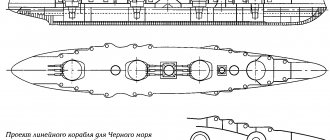Home » Unrealized ship projects » Victims of Washington. Battleships of the South Dakota class (BB-49) (1920). USA
Unrealized ship projects
boroda 12/20/2019 1847
13
in Favoritesin Favoritesfrom Favorites 8
When any naval history buff hears the combination of words - battleship South Dakota, his imagination draws this ship:
It bore the index BB-57 and became famous for its participation in the Second World War.
However, this article will not be about him at all. The fact is that if there had not been the Washington Agreements, which sent a huge number of warships both already under construction and just being designed into oblivion, then this name would have been borne by a completely different ship. I will talk about it in this article.
In 1916, a new shipbuilding program was adopted in the United States. According to it, 10 battleships were to enter service with the US fleet, 6 of which were to be of the South Dakota class. The ships were to bear the names:
— “South Dakota” (BB-49)
— “Indiana” (BB-50)
— “Montana” (BB-51)
— “North Carolina” (BB-52)
— “Iowa” (BB-53)
— “Massachusetts” (BB-54)
The lead of this series of battleships, South Dakota, was laid down in 1920, and at the time of the conclusion of the Washington Agreements was 40% ready. Other ships were laid down later, and their degree of readiness was also lower.
These were to become the most powerful battleships ever to enter service in the US Navy. And even against the background of battleships from the Second World War, they would have looked very competitive. Especially if you evaluate weapons and armor.
In addition to armament and armor, another important condition that the new command imposed on the new ships was that they achieve a maximum speed of 23 knots. Thus, the military wanted to move from a fleet with an average speed of 21 knots to ships that had at least a top speed of 23 knots. This requirement was put forward against the background of a sharp increase in maximum speeds by the battleships of Britain and Japan, whose ships were considered as the main competitors. Another important requirement for the new battleships was the requirement for draft, which should allow ships to freely pass the Panama Canal. Why this demand was made, I think, there is no need to explain to anyone.
But let's return to the technical characteristics of these ships.
Design and armor of battleships of the "South Dakota" class
America fought in the waters of the Atlantic and Pacific Oceans. The Panama Canal was used to quickly move ships from east to west. In this regard, the sizes and shapes of new battleships were designed taking into account the possibility of passing through this isthmus. The body had an unusual box-shaped shape. The length of the vessel was 207 meters. The total displacement was 44,500 tons. Two parallel rudders provided good tactical circulation, its diameter did not exceed 660 m. A pyramid-shaped superstructure surrounded the chimney and was filled with combat and radar weapons.
The armor was calculated based on the enemy's 406 mm guns. The main armor belt had several layers. The outer part was covered with 310 mm Krupp steel. The internal one consisted of 22 mm STS sheets. Between them there was a cement layer 2 inches thick. Installations with the main weapons, as well as the conning tower, were protected by 406 mm and 457 mm plates.
Main caliber 406 mm Mk.VI gun
The power plant included four General Electric turbo gear systems and 8 steam boilers. Its power reached 130,000 hp. The maximum speed was 27.8 knots. In economy mode, the cruising range was 15,000 miles.
The painting of the dreadnought was interesting. Many navies were of the opinion that combat vessels should be given a camouflage pattern. The USA was no exception. Only in 1945 did the US Navy deviate from this rule.
127 mm Mark 12 5″/38 guns
American battleships of the South Dakota project
Battleships of the South Dakota project - a series of four American battleships of the 1940s. The battleships took an active part in World War II and were developed as an improved version of the battleships of the North Caroline project. The North Caroline was distinguished from the battleships by its reinforced armor and large displacement. The ships of the series are considered the strongest in the “battleship” class (an unofficial subclass of “super battleships”).
Dimensions
The battleships of the South Dakota project had a total displacement of 44 thousand tons. The length of the battleships was 207 meters, the width was 33 meters (maximum). The draft was 11 meters when the ship was fully loaded. The dimensions of the battleships were made based on the capabilities of the Panama Canal, which was extremely important for the United States, which had one fleet on the West Coast of the United States and the Hawaiian Islands on one side of the country, and one fleet on the East Coast of the United States.
Driving performance
The South Dakota battleships had a maximum speed of 28 knots, and economic speed (the most optimal for traveling long distances) was 15 knots. The cruising range at economic speed was 15 thousand miles, which was significantly greater than that of the battleships of the First World War (4-6 thousand miles) and most battleships of the 1930s and the Second World War (5-10 thousand).
Armament
The battleships of the South Dakota project had 9 406-mm Mark 6 guns mounted in three-gun turrets. Two gun turrets were placed on the bow of the ship (one behind the other, the second from the bow of the battleship in a slightly raised position to allow firing through the other turret). The third tower was located at the stern. The mass of 406-mm shells is 1025 kg for the light version and 1275 kg for the heavy version.
Main gun of a battleship
The ships of the South Dakota project had very powerful anti-aircraft weapons for ships of their class: - 20 heavy anti-aircraft guns of 127 mm caliber in 10 two-gun turrets, the guns hit air targets at a range of up to 25 km and at altitudes of up to 20 km; - up to 18 (different numbers on different ships) quadruple installations of 40-mm Bofors automatic cannons; — from 16 to 20 (depending on the ship) 20-mm automatic guns Mk1/2/3; — the ship also had 12.7 mm M2 machine guns.
The battleships were built between 1939 and 1942. Four battleships were built: South Dakota, Indiana, Massachusetts and Alabama . The ships had a displacement from 35 thousand to 45 thousand tons (standard and maximum). The battleships had strong armor for the citadel (the central part of the ship's hull), 200-300 mm of steel armor on the side of the ship and 50-100 mm on the deck, and very weak armor for the stern, bow and superstructures. This type of reservation was typical for all American battleships.
A characteristic feature was the presence of strong anti-aircraft weapons, which was not typical for most battleships of that time. Powerful anti-aircraft weapons influenced the purpose of the ships. Battleships were commonly used as part of US carrier strike groups in the Pacific Theater from 1942 to 1945 and served as air defense ships for carrier squadrons. Thus, the lead ship of the South Dakota project in the period from 1942 to 1945 destroyed more than 60 Japanese aircraft with anti-aircraft artillery fire (a number comparable to the air wing of a heavy aircraft carrier of that period), including 13-26 (according to various sources) aircraft in one the battle. The ships were also actively used to shell Japanese coastal fortifications on numerous islands of the Pacific Ocean.
In 1947, all battleships of the South Dakota project were transferred to the Navy reserve. In 1962, the battleships South Dakota and Indiana were scrapped. The battleships Massachusetts and Alabama have been turned into museum ships.
Project ships
Battleship BB-57 South Dakota is the lead ship of the South Dakota project. The ship entered service on March 20, 1942. Until August 1942, the battleship underwent state trials in the North Atlantic. At the end of August, the ship passed through the Panama Canal and headed for the Pacific Theater of Operations. The battleship took part in the battle for the island of Guadalcanal, where it covered the US Marines with main-caliber gun fire. On September 6, the ship's underwater hull caught on a coral reef, receiving serious damage. Due to the damage received, the South Dakota was forced to go to the US naval base Pearl Harbor in the Hawaiian Islands. During the repair process, the ship also received enhanced anti-aircraft weapons (additional 20-mm anti-aircraft guns).
As part of the naval formation TF-16 (the flagship of the formation was the aircraft carrier Enterprise), the battleship left Pearl Harbor on October 12. TF-16, in addition to the Enterprise and South Dakota, also had three heavy cruisers, three light air defense cruisers and 14 destroyers. The group cruised in the coastal waters of the Santa Cruz Islands. The main task of the ship group was to prevent the Japanese fleet from breaking through to the island of Guadalcanal. Also, the American squadron TF-17 with the Hornet aircraft carrier was supposed to approach the group. On October 25, TF-16 spotted Japanese ships using a Catalina patrol aircraft. On the 26th, the TF-17 squadron was 200 miles from the Japanese fleet.
Japanese planes, taking off from their aircraft carriers, attacked the TF-17 squadron. The main target of the attack was the aircraft carrier Hornet. After several attacks, Japanese aircraft disabled the American aircraft carrier, which subsequently sank (the heavily damaged ship, after the crew was evacuated, was finished off by the American ones, then finally finished off by Japanese destroyers with powerful 610-mm torpedoes). After the attack on TF-17, Japanese aircraft switched to TF-16. The main target of the raid was the aircraft carrier Enterprise. However, the aircraft encountered powerful anti-aircraft fire from the squadron. The South Dakota alone shot down 13 to 26 attacking Japanese bombers and torpedo bombers, while being hit by several bombs that did not cause significant damage. The aircraft carrier Enterprise also received several hits from air bombs, but remained combat-ready.
As a result, during the entire battle the Japanese lost about 100 aircraft with the best pilots of Japanese carrier-based aviation. US losses included the aircraft carrier Enterprise, several dozen aircraft (in air battles with Japanese aircraft), one destroyer and several ships were slightly damaged (including the South Dakota and Enterprise).
After the battle, the battleship left for Hawaii. In November 1942, the battleship again set off on a voyage to Guadalcanal. In December 1942, the ship made the transition from the Pacific to the Atlantic. On December 18, the battleship arrived in New York. From February 1943 to August 1943 he was based at the British Home Fleet base in Scapa Flow (Scotland). The powerful American battleship strengthened the British fleet for this period of time. At the end of 1943 he returned to the Pacific Ocean. Until 1945, he took part in hostilities against the Japanese fleet. It was used primarily for air defense of carrier strike groups and artillery shelling of coastal fortifications on numerous Japanese-occupied Pacific islands.
Battleship BB-58 Indiana is the second battleship of the South Dakota project. The battleship carried out combat missions in the Pacific Ocean from November 28, 1942 until the very end of the war. He accompanied carrier strike groups, protecting the squadrons from enemy aircraft. Main caliber guns fired at numerous Pacific islands, including the Philippines (1944) and the Japanese Islands (1945).
The battleship BB-59 Massachusetts became the third ship of the project. The battleship's baptism of fire took place in early 1943 during Operation Torch (liberation of Morocco, Algeria and Tunisia). The battleship fired at coastal targets and entered into battle with the battleship Jean Bart. From late 1943, the ship participated in operations in the Pacific Ocean, performing the same tasks as the South Dakota and Indiana. The ship's most successful combat operations in the Pacific Ocean were participation in the naval battle in Leyte Gulf (1944) and the shelling of the Japanese island of Honshu (1945).
Currently converted into a museum ship and located in Fall River, Massachusetts (USA).
The BB-60 Alabama was the last battleship of the South Dakota series, based in the Atlantic and Pacific Oceans. The very last of the series entered service (at the end of 1942). The battleship was turned into a museum ship in 1964. The ship is based in Mobile Bay, Alabama (USA).
Battleship Alabama in Mobile Bay
Source
Armament of battleships of the "South Dakota" class
- The main caliber was identical to the previous series of battleships. 3 three-gun turrets contained 406 mm Mk.VI cannons. Two superstructures were located in front of the ship, and one more at the stern. The armor-piercing shells of this artillery were heavy. Thanks to the hinged flight path, they could penetrate any enemy deck located at a distance of more than 36 km. Since 1942, the Mk.VI began to use another type of ammunition - high-explosive.
- Medium artillery included 10 pairs of 127 mm Mark 12 5″/38 guns. They provided anti-ship protection and performed excellent anti-aircraft functions. The rate of fire reached 22 rounds per minute.
- The air defense had a large number of 40 mm Bofors guns, 28 mm Mark 1/1, 20 mm Mk.2/3/4 and 12.7 mm Browning M2 heavy machine guns.
- Aviation consisted of 3 OS2U Kingfisher seaplanes.
Air defense system
Ships in class[edit]
| Name | Shipyard | Put it down | Suspended | Canceled | % Completed [21] | Fate |
| South Dakota (BB-49) [22] | New York Navy Yard | March 15, 1920 | February 8, 1922 | August 17, 1922 | 38,5% | Sold for scrap, October 25, 1923 |
| Indiana (BB-50) [23] | November 1, 1920 | 34,7% | Delivered on the slipway | |||
| Montana (BB-51) [24] | Mare Island Naval Shipyard | September 1, 1920 | 27,6% | Sold for scrap, October 25, 1923 | ||
| North Carolina (BB-52) [25] | Norfolk Navy Yard | January 12, 1920 | 36,7% | |||
| Iowa (BB-53) [26] | Newport News Shipbuilding | May 17, 1920 | 31,8% | Sold for scrap, November 8, 1923 | ||
| Massachusetts (BB-54) [27] | Fore River Shipyard | April 4, 1921 | 11,0% |
the South Dakota -class battlecruisers
and Lexington existing guns were transferred to the US Army and used as coastal defense guns. [16] Their boilers were used to modernize six ships of the Florida, Wyoming and New York classes in the mid-1920s; their armor plates were used to reinforce the existing armor of other battleships. [28]
Service
All 4 battleships were built to participate in World War II. They were part of naval formations and provided protection for aircraft carriers and other ships against air attack. During the battle with Japan near the Santa Cruz Islands, the captain of the South Dakota reported to management that he had shot down 26 enemy aircraft. At the same time, the ship itself received multiple damage, but the design and good armor of the ship allowed it to continue the fight.
Large and medium caliber were used to attack the enemy coast. Thus, the Massachusetts acted as artillery support during the landings on the Solomon Islands, New Guinea, and in 1945 it shelled the Japanese cities of Kamaishi and Hamamatsu.
In 1947, the ships were sent to reserve. After 15 years, two of them were scrapped, two more are currently serving as museum exhibits.
Power point.
The South Dakota battleships were to be equipped with a turbo-electric propulsion system, which was adopted by the US Navy starting with the New Mexico-class battleships. American engineers resorted to these tricks because of one bottleneck in American industry. The fact is that the industry could not make reliable mechanical gearboxes for such powerful power plants that battleships had. In addition, this drive design gave another advantage that could not be achieved using gearboxes - the reverse speed on American battleships was the same as the forward speed. But this is not all the advantages that the turbo-electric power plant provided. It made it possible to arrange the vehicles more densely and thus reduce the size of the engine room, which could not but have a positive effect on the survivability of battleships. Now it was much more difficult to disable their vehicles and immobilize the battleship.
By the way, in the pictures everyone can notice how smaller the engine room of American battleships is than that of their counterparts from other countries. But let’s return to the actual power plant of the South Dakota-class battleships.
On the battleship South Dakota, two General Electric turbogenerators were installed; for the battleships Indiana and Montana, the generators were to be supplied by Westinghouse. These generators had an alternating current capacity of 28,000 kVA and produced a voltage of 5,000 volts. 4 DC electric motors were connected to them, one per propeller shaft, with a power of 11,200 kilowatts (15,000 hp).
The power plant itself consisted of sixteen water-tube boilers, which, in total, produced 60,000 horsepower. With such power equipment, the maximum speed was expected to be 23 knots (43 km/h).
Economy
The state of South Dakota is one of the poorest in the country. This is due to the small population, as well as soil characteristics and historical events. The most developed area is the service sector. These are trade, tourism, finance, and the medical industry.
Cattle and pigs are raised in the region. They grow corn, soybeans, and wheat. The state of South Dakota produces large quantities of ethyl alcohol and ranks 6th in America for this parameter.
Also, until 2002, gold was mined here, but after the development of the deposits, the mines were closed.
Attractions
The state of South Dakota dates back to the period of the development of the Wild West, which left a big imprint on its culture.
Various festivals dedicated to historical heritage and events are held here every year.
Tourists will be interested in coming here for the 76th Day (Deadwood) or St. Patrick's Day holiday.
Deadwood City
The region hosts meetings of Indians - pow-wows, at which national songs and dances are performed, the peculiarities of Indian culture are discussed, and traditions are remembered and revived.
pow wow
The state of South Dakota is also famous for its monument carved on Mount Rushmore. It contains portraits of four US presidents.
Mount Rushmore
The landscapes are unusual and breathtaking. In national forests and parks you can see steep hills sharpened by erosion, numerous prairies, and cliffs with sharp peaks. Many of these phenomena are protected as the only ones in the world.
Badlands Park
Park Kuster
Palisades Park
Story
These lands were discovered by Europeans only in 1743 as a result of an expedition organized by the French. The future state of South Dakota became part of France's colonies in the New World.
South Dakota, 1743
The land came to America in 1803 as a result of the Louisiana Purchase. After the discovery of gold deposits, a large stream of prospectors poured here, which led to a major confrontation with the Sioux Indians, as a result of which the latter were largely exterminated.
However, after the phenomenon called the “Dust Bowl” and which destroyed a large amount of fertile soil, the state of South Dakota was abandoned by the bulk of the inhabitants, which significantly affected the current state of affairs.
Quotes [edit]
- Friedman (1985b), p. 155.
- Friedman (1985b), pp. 155-156.
- Ships' Data (1921), p. 32.
- Friedman (1985b), pp. 156-157.
- ^ ab Breuer (1973), p. 232.
- Friedman (1985b), p. 164.
- Friedman (1985b), p. 156.
- Friedman (1985a), p. 118.
- Breuer (1973), p. 193.
- Friedman (1985b), p. 446.
- Ships' Data (1921), p. 31.
- ^ ab Breuer (1973), p. 218.
- ↑
Anderson and Baker (1977), p. 312. - ↑
Anderson and Baker (1977), p. 327. - Friedman (1985b), p. 457.
- ^ a b Campbell (1985), p. 116.
- Campbell (1985), p. 132.
- ^ ab Ships' Data (1921), page 30.
- ↑
Campbell (1985), pp. 145–146. - ^ ab Friedman (1985b), pp. 162, 446.
- Friedman (1985b), pp. 420-421.
- ↑
Evans, Mark L. (September 14, 2015).
"South Dakota (Battleship No. 49)". Dictionary of American Naval Combat Ships
. Naval Bureau, Naval History and Heritage Command. Retrieved March 10, 2022. - Cressman, Robert J.; Evans, Mark L. (September 12, 2016). "Indiana I (Battleship #1)". Dictionary of American Naval Combat Ships
. Naval Bureau, Naval History and Heritage Command. Retrieved March 10, 2022. - Cressman, Robert J (February 18, 2016). "Montana (Battleship No. 51)". Dictionary of American Naval Combat Ships
. Naval Bureau, Naval History and Heritage Command. Retrieved March 10, 2022. - "North Carolina II (Armored Cruiser No. 12)". Dictionary of American Naval Combat Ships
. Naval Bureau, Naval History and Heritage Command. February 18, 2016. Retrieved March 10, 2022. - Evans, Mark L. (April 20, 2016). "Iowa II (Battleship No. 4) 1897–1923". Dictionary of American Naval Combat Ships
. Naval Bureau, Naval History and Heritage Command. Retrieved March 10, 2022. - "Massachusetts IV". Dictionary of American Naval Combat Ships
. Naval Bureau, Naval History and Heritage Command. February 18, 2016. Retrieved March 10, 2022. - Friedman (1985b), pp. 156, 193.
Bibliography[edit]
- Anderson, Richard M. and Baker, Arthur D. III (1977). "CV-2 Lex and CV-3 Sarah." Warship International
.
Toledo, OH: International Naval Research Organization. XIV
(4): 291–328. ISSN 0043-0374. - Breuer, Siegfried (1973). Battleships and Battlecruisers, 1905-1970: Historical Development of the Capital Ship
. Translation by Alfred Kurti. London: Macdonald and Jane. ISBN 0-356-04191-3. - Campbell, John (1985). Naval weapons of World War II
. Annapolis, MD: Naval Institute Press. ISBN 0-87021-459-4. - Friedman, Norman (1985a). "United States". In Grey, Randal (ed.). Conway's Fighting Ships of the World: 1906–1921
. Annapolis, MD: Naval Institute Press. ISBN 0-87021-907-3. - Friedman, Norman (1985b). US Battleships: An Illustrated History of Design
. Annapolis, MD: Naval Institute Press. ISBN 0-87021-715-1. - Ship Data, United States Naval Vessels. US Navy. July 1, 1921
